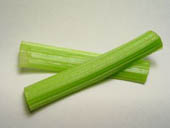
Purpose
To create stalks of colorful celery while demonstrating how plants need and draw water to survive.
Additional information
Boring celery. That green leafy vegetable that can be cut down to stalks is in itself boring and unappealing. In this experiment we'll spruce up celery so children don't avoid it like it's the pneumonic plague. By the time we're done, we'll have a colorful array of celery that can actually be eaten while at the same time having demonstrated an important lifecycle trait of plants. It's fun, easy, and will turn that boring celery into something colorful and fun!
Sponsored Links
Required materials
- 6 Long stalks of celery
- Chopping board
- Knife
- Red and blue food coloring
- 6 drinking glasses
- Water
- Vegtable peeler
- Pen or pencil (optional)
- Journal to record observations (optional)
Estimated Experiment Time
From 1 hour to 48 hours
Step-By-Step Procedure
- 1. Cut the pieces of celery to the same length, tall enough to fit into the glasses so they'll be completely submerged by water. Make sure to chop off the bottom and the top at the leafy part so you're left with the stalks.
- 2. Fill each of your 6 glasses with an equal amount of water, about 3 inches from the top.
- 3. Add 10 drops of red food coloring each to 3 of the cups.
- 4. Add 10 drops of blue food coloring each to the remaining 3 cups.
- 5. Place one piece of celery into each glass. After this step you'll have 6 cups, 3 with red coloring and 3 with blue coloring and each with a stalk of celery submerged in it.
- 6. After 2 hours, take a stalk of celery out of a glass with blue food coloring. Has the color of the celery changed? Use your vegetable peeler to peel the stalk of celery and see how far the change has gone. Write the results in your journal.
- 7. Remove a stalk of celery at the intervals of: 2 hours, 4 hours, 8 hours, 24 hours, and 48 hours (you have 6 glasses, and thus 6 stalks of celery).
- 8. After each interval has passed, remove a stalk and peel it, notating in your journal the changes to the celery after each interval.
Note
Be very careful cutting your celery! If you're young, you'll need an adult to help you with this experiment as handling sharp objects can be dangerous. Celery is soft enough to cut with a butter knife, so favor that when cutting the stalks.
Observation
As you peeled each stalk at each interval, what happened to the celery? What was the depth of color after each interval passed? What factors do you believe would influence the feeding process of the plants? What if you were to put the stalks in a darkened room or add sugar to the water?
Result
Just like people and animals, plants need water to survive. Plants get water from the dirt through their roots. Inside the plants are capillaries that allow the water to travel through the plant. These capillaries are hollow and function as a "straw" for the plants. You can witness from the celery that over an extended period of time the plant draws water through its capillaries all the way through its system. As the water is drawn up a vacuum is formed at the top and the colorful water is forced through the celery stalk, causing the celery to turn color.
Sponsored Links
Take a moment to visit our table of Periodic Elements page where you can get an in-depth view of all the elements,
complete with the industry first side-by-side element comparisons!